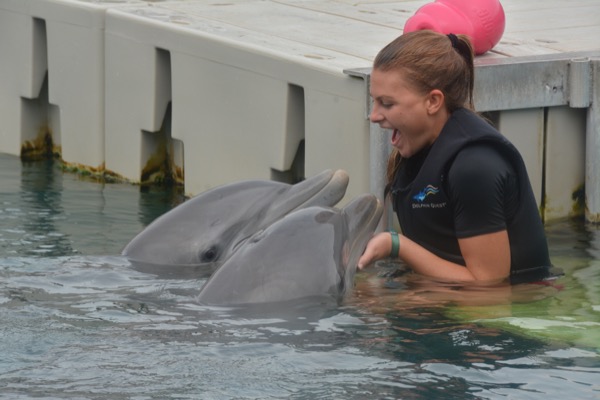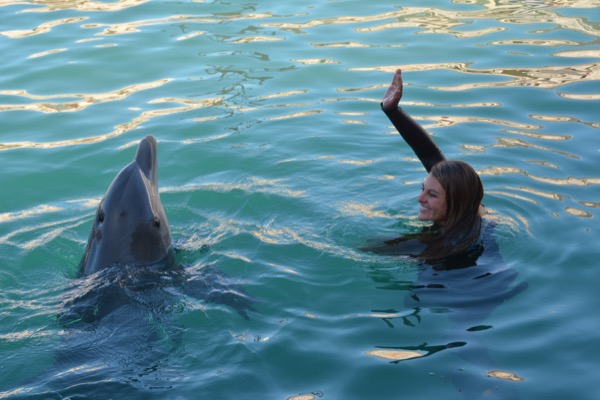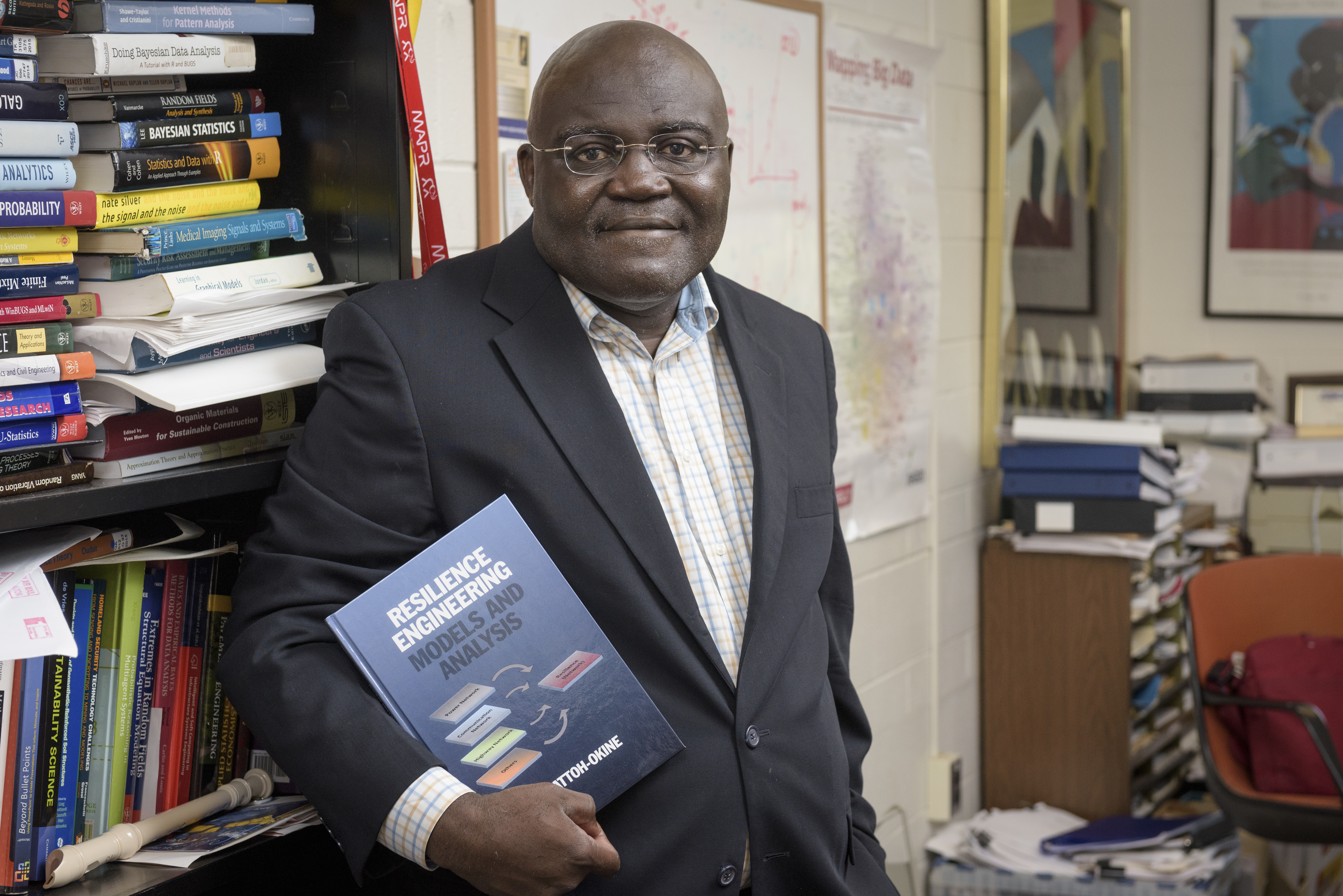Dolphin psychology
UD graduate fulfills lifelong dream to work with dolphins
11:06 a.m., April 20, 2016--University of Delaware graduate Jenna Billings is putting her psychology and animal science education to good use, helping to get inside the minds of marine mammals at Florida’s Dolphins Plus. There she is learning to train dolphins and inform the public about conservation issues, while also fulfilling her lifelong dream to work with dolphins.
Dolphins Plus is committed to the conservation and protection of marine mammals worldwide and is actively involved in research — constantly trying to learn and discover new things about the species — with extensive education and outreach programs. The organization is located in Key Largo, and has facilities on the Atlantic and on the Gulf of Mexico.
People Stories
'Resilience Engineering'
Reviresco June run
Billings is at the Bayside facility on the Gulf of Mexico, a job she started in February, where she works with 11 Atlantic bottlenose dolphins — two of which are eight months old — and two California sea lions, which have their own trainers.
The interactive facility is open to the public and offers programs such as a structured swim during which guests can get into the water with the dolphins to do various behaviors with them, and a shallow water encounter for guests who are younger or not comfortable in the water. Guests who still want to meet and interact with a dolphin without getting into the water can do so by signing up for a kiss with a dolphin or paint with a dolphin, several of which happen to be quite the artists.
“We hope to inspire conservation and protection of marine mammals through our guest interactions. By our guests observing or being in the water, we hope that they will form a connection with these animals and be inspired to make a difference and help protect the dolphins and all of the other animals out in the wild,” said Billings.
Billings said that one of her favorite parts of the job is seeing a guest interact with a dolphin for the first time.
“Some of the guests who’ve never seen a dolphin before, or never been up close and personal with a dolphin, just think it’s the coolest thing ever. It’s really great to see that we can instill that passion in others,” said Billings.
Teaching dolphins
Billings also said she enjoys asking the dolphins for various behaviors.
“Just like humans, dolphins learn differently. Seeing what they find reinforcing and seeing what works better for each individual dolphin is really neat. When you end up training a behavior, you can relate it to a school teacher explaining a new concept to her students. It's a really rewarding job," said Billings.
Billings is still in her three-month training period and because she is a new face to the dolphins, she is getting to know them and allowing them to get to know her in order to build relationships.
“I’ve been working with some of the dolphins more so than others and I can already see a relationship forming with some of them. They seem more comfortable around me and they get really excited around me. Just seeing that is rewarding. And knowing that you are helping provide amazing care to these animals, I absolutely love that aspect of the job,” said Billings.
As a dolphin trainer, Billings will eventually get to do things like train new behaviors with the dolphins and swim and work with the dolphins more as her time with Dolphins Plus goes on.
Dolphin communication
Billings said the primary way trainers communicate is through what’s known as a bridge.
“If you’ve seen trainers with a whistle, that’s an auditory bridge so we can use that to communicate with the dolphin when they do what we are looking for. That tells them, ‘Yes, that was perfect. Great job.’ Once we blow the whistle, we start to pair that with what we call primary reinforcement,” said Billings, adding that an example of primary reinforcement is fish.
"The more the dolphins associate hearing the whistle and the whistle being paired with something they find reinforcing, soon enough the whistle will become reinforcement on its own, and won't always have to be backed up. The dolphins come to learn that the whistle communicates to them yes, good job and to come back to the trainer," said Billings.
Billings said another way trainers communicate with the dolphins is through hand signals, almost like a sign language, in order to train behaviors.
“It usually starts with what’s called a hand target. That’s when you present your hand and the dolphin’s mouth — also known as their rostrum — will come into contact with that hand and soon they’ll learn to follow that wherever it goes,” said Billings.
That hand will get extended to what’s called a target pole, which the dolphins learn to follow. Once they get the motion of the behavior, the trainers incorporate a hand signal so the dolphins will eventually be able to associate the behavior with the hand signal.
History with dolphins
With regard to her prior experience working with dolphins, Billings said that she interned at Dolphins Plus last summer for three months before interning at Dolphin Quest in Bermuda.
“I learned a lot from those internships. Both were pretty hands-on and within my last month at Dolphin Quest, I got hired back here,” said Billings.
Her love of dolphins began when she was young and would visit Sea World when taking trips to see her grandparents in Florida.
“I was really young — about five years old — the first time I saw a dolphin. My grandparents live an hour away from Orlando so growing up, it was really nice. Over the summer, my family would come down and visit them, and we would do a lot of fun things. One of my favorites was visiting Sea World," said Billings.
She thought it was “mind-blowing” that the trainers could get in the water and interact with the dolphins.
“I was intrigued and blown away and ever since that moment, I wanted to be a trainer,” said Billings.
Billings said that her time at UD helped prepare her for her current job as some of the classes in her psychology major go hand-in-hand with what she is doing with the dolphins and her animal science minor allowed her hands-on experience with animals — especially in her senior year swine production capstone course.
“Never in my life did I think that I’d fall in love with pigs but I did, and it was really cool how hands-on that class was. The University of Delaware has an amazing animal science and agricultural program. For any students who are looking at places to go and looking for where they can get the experience that they need, I would definitely put UD out there. It was a great school for me. I absolutely loved it. The program is unbelievable and it helped me achieve my dream job, so that’s really awesome,” said Billings.
Article by Adam Thomas












